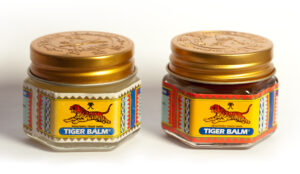Why is Tiger Balm Illegal? Exploring the Controversies and Regulations

Understanding Tiger Balm: Ingredients and Uses
Tiger Balm is a well-known topical analgesic that has been used for over a century to provide relief from various ailments, particularly pain and discomfort associated with muscle strains, headaches, and joint pain. Originating from traditional Chinese medicine, Tiger Balm’s formulation includes a blend of natural ingredients, each contributing to its therapeutic effects. The primary components of Tiger Balm are camphor and menthol, both of which are responsible for creating a soothing sensation upon application and promoting blood circulation in the affected areas.
Camphor, derived from the wood of the camphor tree, has been utilized in various medicinal contexts due to its anti-inflammatory properties. It acts as a counterirritant, meaning it causes irritation in one location, which helps to diminish pain in another. Menthol, on the other hand, is extracted from peppermint oil and is praised for its cooling effect, which can provide quick relief from pain when applied to the skin. This combination of camphor and menthol is pivotal to the effectiveness of Tiger Balm as a pain relief solution.
Beyond its primary ingredients, Tiger Balm also contains a variety of herbal extracts, including cajuput oil, clove oil, and cinnamon oil. These additional ingredients contribute to the balm’s potency and enhance its aromatic profile, making the application more pleasant. The use of these natural components is paramount in the traditional approach to healing, and they reflect the holistic view inherent in many Eastern medicine practices.
Although Tiger Balm has establish a solid reputation for its effectiveness in alleviating pain, its ingredients can be contentious in certain jurisdictions due to potential allergic reactions or regulatory restrictions. Understanding the composition of Tiger Balm and its historical context is crucial to appreciating the ongoing discussions surrounding its legality and acceptance in various markets.
Legal Status of Tiger Balm in Different Countries
Tiger Balm, a traditional herbal remedy used for pain relief, has gained significant popularity worldwide. However, its legal status varies greatly across different regions. In countries such as the United States and Canada, Tiger Balm is generally accepted and sold as an over-the-counter topical analgesic. These nations recognize its benefits for minor muscle and joint pain, tension headaches, and even insect bites. Their regulatory bodies, like the Food and Drug Administration (FDA) and Health Canada, have guidelines that govern the labeling and marketing of such products, ensuring consumer safety.
In contrast, certain countries impose restrictions or outright bans on Tiger Balm due to health regulations and safety concerns. For instance, in some European nations, specific components found in Tiger Balm, such as camphor and menthol, are regulated under strict legal frameworks due to potential side effects when used improperly. These regulations often stem from a proactive stance to ensure that traditional herbal remedies do not pose health risks to consumers. They may require extensive studies on the product’s safety and efficacy before granting approval for sale.
Moreover, some regions actively discourage the use of traditional remedies like Tiger Balm, primarily because of their lack of scientific backing. In these countries, regulatory authorities place emphasis on evidence-based medicine, leading to stringent conditions under which herbal products can be marketed. Consequently, health departments may implement policies that restrict sales either completely or in specific formats, such as limiting its distribution to licensed practitioners. While Tiger Balm remains a beloved remedy for many, understanding its varied legal landscape is crucial for consumers, healthcare providers, and policymakers alike.

Health Risks and Controversies Surrounding Tiger Balm
Tiger Balm, a popular topical analgesic, is commonly used for pain relief. However, several health risks and controversies have emerged regarding its use. One of the primary concerns is the potential for allergic reactions, particularly in individuals with sensitive skin. Ingredients such as menthol and camphor, while effective in providing relief, can lead to dermatitis, rashes, and other adverse reactions in susceptible individuals. In some documented cases, users have experienced severe allergic reactions, necessitating medical intervention. These incidents raise pertinent questions about the safety of topical analgesics like Tiger Balm, especially for those with known allergies or skin conditions.
Improper usage of Tiger Balm also presents risks. Users may apply it in excessive amounts or on compromised skin, resulting in irritation or chemical burns. In addition, the product is often misapplied to sensitive areas such as the eyes or mucous membranes, causing significant discomfort and injury. Health professionals emphasize the importance of adherence to instructions when using such topical medications, but anecdotal evidence suggests that many do not take these warnings seriously, thereby increasing the likelihood of adverse effects.
The composition of Tiger Balm has also sparked debates within the medical community. While many users report positive outcomes, healthcare providers express concerns about the long-term safety of its ingredients. As a result, some regions have placed regulations on its sale, especially where alternative remedies are more rigorously scrutinized. Critics argue that while natural ingredients might seem safer, they can still pose risks, particularly when used without proper guidance. Thus, the ongoing dialogue concerning the safety profiles of products like Tiger Balm continues, exacerbating the question: why is Tiger Balm illegal in certain jurisdictions?
The Future of Tiger Balm: Possible Regulatory Changes
As global health trends evolve, the future of Tiger Balm appears to be at a crossroads, shaped by ongoing research and changing perceptions towards herbal remedies. Historically celebrated for its analgesic properties, Tiger Balm has garnered a loyal following, particularly among those who favor alternative treatments. However, with an increasing emphasis on safety and efficacy, regulatory bodies are reevaluating the acceptance and legality of such products worldwide.
Recent studies have highlighted the need for more rigorous scientific validation of herbal remedies, including those like Tiger Balm that contain active ingredients such as camphor and menthol. The drive for evidence-based health practices is prompting regulatory authorities in various nations to reconsider their stance on the regulatory status of traditional remedies. In some regions, this could lead to stricter oversight and demands for comprehensive clinical trials, ensuring that such products meet modern health standards.
Additionally, public perception of herbal treatments is gradually shifting. While some consumers remain steadfast in their belief in natural remedies, there is a notable rise in skepticism regarding unregulated products. This evolving viewpoint may influence legislation, pushing lawmakers to create frameworks that protect consumers while allowing for the continued use of traditional medicines like Tiger Balm. Balancing consumer safety with the rich legacy of herbal medicine presents a complex challenge for regulators.
As awareness surrounding the potential risks associated with herbal products grows, the future accessibility of Tiger Balm may depend significantly on how well these challenges are addressed. Advocacy for transparent labeling, substantiated health claims, and informed consumer education will be pivotal in shaping the landscape of herbal remedies. Ultimately, the evolution of regulatory approaches will play a crucial role in determining whether Tiger Balm can coexist within modern health paradigms, resonating with those who appreciate its historical significance while adhering to contemporary safety standards.



